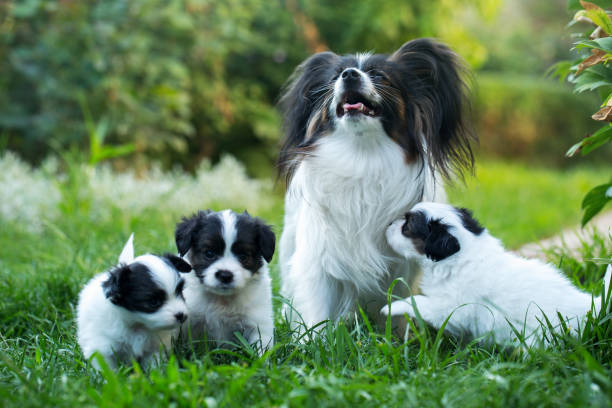Papillon Spaniel

Breed History:
The Papillon, also known as the Papillon Spaniel, is one of the oldest toy spaniel breeds, with a history dating back over 700 years in continental Europe. The breed’s name, meaning “butterfly” in French, comes from its distinctive fringed ears, which resemble butterfly wings.
Originating in France and Belgium, Papillons were popular among European nobility, frequently featured in Renaissance paintings alongside royal families. The breed descended from early dwarf spaniels, evolving into two ear types: the erect-eared Papillon and the drop-eared Phalène. Both are considered the same breed under FCI standards.
Despite its dainty appearance, the Papillon is an alert, athletic, and spirited companion.
Height: 20-28 cm
Weight: 3.5-5 kg
Size: Toy
Life Expectancy: 13–16 years

Breed Appearance:
The Papillon is a small, fine-boned dog with an elegant build and plumed tail arched over the back. Its most notable feature is the large, erect ears, fringed with long hair and shaped like a butterfly’s wings.
The coat is long, flowing, and silky, with feathering on the ears, chest, legs, and tail. Coat colours are always white with patches of any other colour, most commonly red, black, or sable.
Breed Type – Companion/ Toy Spaniel:
Though bred as a lapdog and companion, the Papillon is remarkably agile and smart. It has the spirit of a spaniel—curious, energetic, and alert.
It excels in dog sports like agility and obedience, and thrives on interaction and mental stimulation. This breed is cheerful, loyal, and surprisingly tough for its size.

Training:
Papillons are highly intelligent and eager to please, making them easy to train. They excel in:
-
Obedience
-
Agility
-
Tricks
-
Therapy work
Training should be positive and fun, as the breed is sensitive and responds poorly to harsh methods. Early socialisation helps reduce timidness.
Health & Care:
Papillons are generally healthy but can be prone to:
-
Patellar luxation
-
Dental disease (common in toy breeds)
-
Progressive retinal atrophy (PRA)
-
Collapsed trachea
-
Hypoglycemia in puppies
Routine dental care, vet checkups, and joint monitoring help maintain long-term health.

Living Conditions:
The Papillon adapts well to apartment living, but it is not a couch potato. It needs daily activity and interaction. It enjoys both indoor games and outdoor walks.
Though small, it prefers being part of the family’s routine and dislikes being left alone for long periods. It is best suited to homes where someone is present most of the day.
Exercise:
Papillons have moderate energy levels and enjoy:
-
Short walks and playtime
-
Indoor fetch or agility activities
-
Puzzle toys and training games
Daily stimulation is important, but they don’t need intense exercise.
Grooming:
Moderate grooming needs:
-
Brush 2–3 times a week to prevent tangles and maintain coat health
-
Bathe occasionally
-
Clean ears regularly, especially due to fringed ear hair
-
Routine dental care and nail trimming
They do not have an undercoat, so shedding is light and seasonal.

Advantages:
-
Intelligent and highly trainable
-
Affectionate and loyal to owners
-
Good with other pets and polite children
-
Low shedding and manageable grooming
-
Compact size suited for small homes
-
Long lifespan and generally robust health
Disadvantages:
-
May be vocal and alert—can bark excessively
-
Fragile—requires careful handling, especially with young children
-
Needs mental stimulation to avoid boredom
-
Prone to separation anxiety if left alone too long
-
Dental care and joint health must be closely managed
-
May be timid if not socialised early

